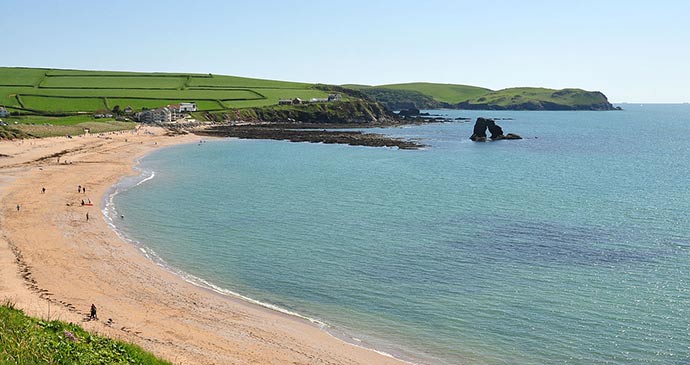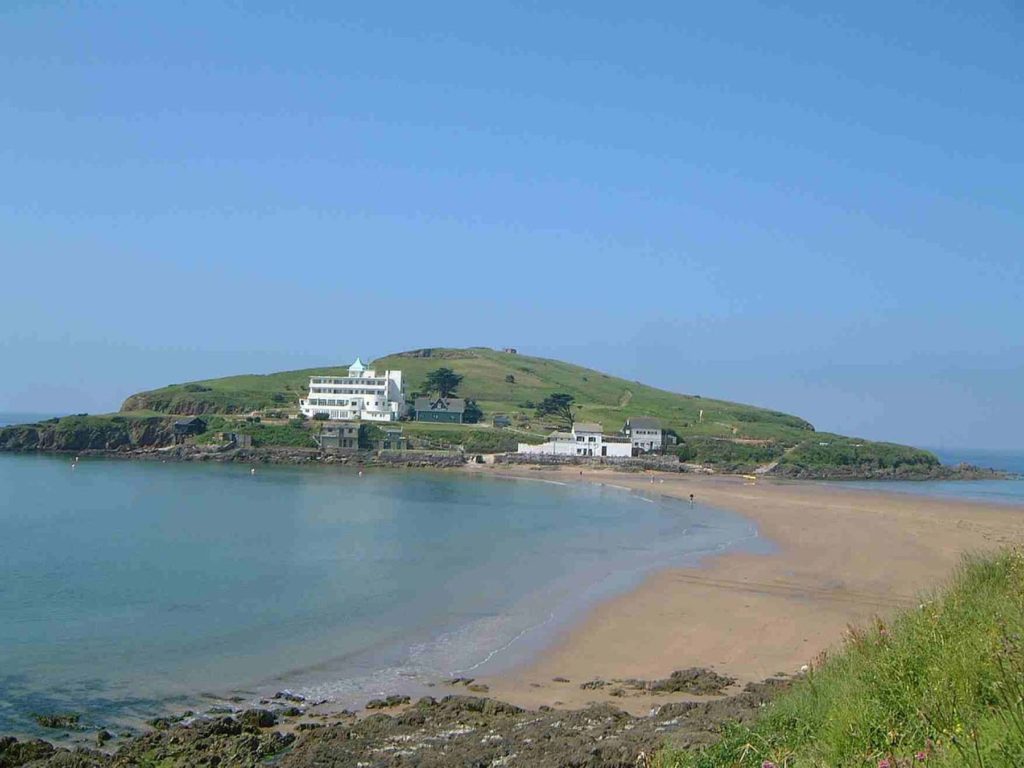When it comes to swimming beaches, Devon is one of the best regions in the UK.
A far cry from swimming countless lengths in a pool, swimming outdoors offers the chance to become part of your environment by literally immersing yourself in it. Every swim is a new experience: spot sand eels in the shallows, watch moon jellies drifting by, or swim over a shoal of seabass.
It’s easy to lose track of time and distance when the view above and below the surface constantly changes. Wild swimming is all about the journey, whatever the distance. It can be a social occasion too, whether it’s a gentle swim with friendly chatter or a mass participation event with a real buzz.
Here are some of my favourite beaches for wild swimming in Devon.
South Milton Sands
A great novice swim is from South Milton Sands at high tide to Thurlestone Rock, under the arch and back again.

The diversity of seaweeds in such a small patch of seashore is amazing – go back on a low spring tide and carefully walk through the arch to admire the marine life from a different perspective.
Tavy and Walkham Rivers
The river is shallow and fast-flowing and tumbles its way towards the Tavy in a series of rapids with some calm stretches in between. It is too shallow for swimming but it is possible to wallow in the shallows for a natural jacuzzi on warm day.

There are better swimming areas around the confluence itself. As the Tavy curves round to meet the Walkham, there is a short calm stretch near the bank but the current can be strong in parts and sweep you downstream if you’re not careful.
Foggintor Quarry
If you’re following the Plymouth and Dartmoor railway track from Merrivale to Princetown, a short detour to Foggintor Quarry is well worth it. Wild swimmers can walk around the left side of the quarry wall and enter the water from there. It’s deep in parts but very shallow in others, with large rocks just below the surface.

It isn’t ideal for anything too enthusiastic but it’s great for sheer atmosphere, and offers a different perspective on the imposing faces of the quarry.
Fingle Bridge & the Teign Gorge
Just upstream from Fingle Bridge, there is a small deep pool above Fingle Weir which is great for a quick dip. A mile and a half upstream from here is a long, calm, shady (and rather bracing) stretch of water above Drogo Weir, just downstream from an iron bridge and the Hunter’s Path which will take you on the long wind up to the Castle Drogo Estate.

Just below the weir is a series of pools – Salmon Leaps – built by castle Drogo’s original owner, Julius Drewe, to assist the upward migration of salmon, which doubles as a natural whirlpool for wild swimmers.
The River Dart
The River Dart is one of Devon’s most popular rivers for swimming. Its clear waters, stained the colour of dark red amber by the peaty soil, rush down from the high moor, cascading over large, smooth stones and widening towards Totnes where the river becomes tidal. A popular stretch on Dartmoor itself is around Newbridge.

From here, the beautiful Sharrah Pools are a 40-minute walk upstream through the National Trust’s Holne Woods. Closer to Newbridge itself, the river is shallow and turbulent, thrust into small waterfalls as it courses over large boulders, but there are still some lovely deep, calm parts to be found on the left bank, perfect for a swim between the banks of birch and ancient oaks.
Once the Dart has left Dartmoor, there are numerous swimming spots en route to Totnes. A favourite along this stretch is Still Pool: a wide, calm and reasonably deep section outside the village of Staverton, just below the weir.
River Avon
Swimming up the Avon River against the tide is the wet equivalent of a treadmill. Park at Bantham (at the estuary mouth just north of Thurlestone), then walk anticlockwise around the ‘ham’ and take the first path to the pink thatched boat-house and slipway. Stick to the outside edge of the bend (the river runs fastest mid-stream) and swim upstream on a dropping tide for a real workout, then it’s a quick drift back.

Each year the Bantham Swoosh takes place down the River Avon. Promoted by the Outdoor Swimming Society, this is a 6km swim from Aveton Gifford to Bantham, and includes the Swoosh where the river narrows, propelling swimmers towards the sea on the receding tide. And you don’t have to wait for the official Swoosh date to do this!
Burgh Island
The jewel in the crown of Devon’s sea swims has to be Burgh Island.

With two annual events around the island, you can choose the official ‘Round the Island’ race in August or the more relaxed Chestnut Appeal Burgh Island Swim in autumn – a chance to savour the spectacular 360° views.
Salcombe
Build up your stamina by swimming 200-yard widths at North Sands, Salcombe. The water is crystal clear and you’re never far out of your depth; just avoid the boat lane in summer. Swimming across Salcombe estuary is dangerous, but once a year safety measures are in place for the Salcombe Regatta Harbour Swim from Small’s Cove to Bakerswell every August.

For the more adventurous, persuade a friend with a boat to escort you from Starehole Bay to North Sands (just south of Salcombe) on an incoming tide. Alternatively, cross by ferry from Salcombe to East Portlemouth and walk south to the Hipples, a magical part of the sand bar exposed at low spring tides, then swim up past Mill Bay, back to East Portlemouth.
More Information
Keen to discover more wild swimming spots in South Devon? Take a look at our comprehensive travel guide: